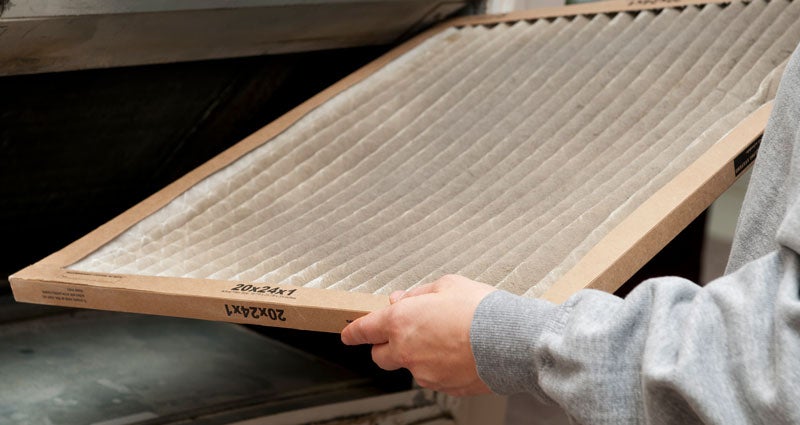Mold allergies: Skin rashes, eczema and treatment

If you have allergies that last longer than a season or two, it’s possible you have a mold allergy. Mold allergies are a common cause of chronic allergies. Because mold can occur inside the home, at your place of work and outdoors, you can be exposed to this allergen year-round.
What are the symptoms of a mold allergy?
Mold and mildew are fungi. In order to reproduce, fungi produce spores that travel through the air. These spores are similar to pollen in that they can cause allergies in some people. Common symptoms of a mold allergy include:
- Sneezing
- A runny or stuffy nose
- Itchy, water eyes
- Coughing
- Itchy throat
In addition, a mold allergy can trigger asthma symptoms.
Can a mold allergy cause a rash?
Some people find that they also develop dry, itchy or scaly skin as a result of a mold allergy.1 This is often a result of mold spores coming into contact with the skin. If you are very sensitive to mold or come into direct contact with it, you may develop a rash known as atopic dermatitis, or eczema. If you have a rash, a dermatologist can help you identify if it is atopic dermatitis and propose potential solutions or treatment options. You can get a treatment plan from a Teladoc Health dermatologist in two days. Just upload a photo of your rash to the Teladoc Health app.
Where does mold grow?
Because fungi like mold and mildew can thrive in wet, dark areas, they are commonly found in humid or damp areas of the home. These spaces can include your kitchen, basement or bathroom. In addition, if you live in a humid climate, it’s more likely that you have mold growing in your home, as mold thrives in humidity. Mold can also grow in carpeting, upholstery, trash bins, shower curtains and potting soil.
What is black mold? Are black mold allergy symptoms different?
Many different types of mold are black. However, when referring to black mold, most people are talking about Stachybotrys chartarum, or toxic black mold.2 This is a type of mold that often grows on common building materials like gypsum board, fiberboard and paper. Because constant moisture is required for it to grow, toxic black mold grows when there is moisture from water damage, leaks, condensation or flooding. Black mold allergy symptoms are similar to other mold allergies. According to the CDC, all mold should be treated the same with respect to potential health risks and removal.
How can I treat my mold allergy symptoms?
If you or your family members have an allergy to mold, you can learn more about allergies and treatments here. A Teladoc Health doctor can help diagnose your symptoms and provide you with proper treatment. They can also recommend over-the-counter antihistamines and nasal decongestants. These medicines help with symptoms like runny or stuffy nose, congestion, cough and sneezing.
How can I remove mold from my home?
The best way to treat your mold allergy symptoms is to reduce your exposure to mold. Here are some tips for avoiding mold or eliminating it from your home:
- Use a dehumidifier to keep the humidity in your home below 45%. Don’t forget to clean the fluid reservoir regularly, which can be a source of mold growth too.
- Use allergy- and asthma-friendly filters in your central air conditioning, or get an air-purifying system with a HEPA filter.
- Repair any roof or plumbing leaks. Check windows and doors for leaks, drips or condensation buildup.
- Make sure all water from storms drains away from your home. Keep foundations and gutters clear of moisture, leaves and debris.
- Clean your sinks and tubs regularly, as mold thrives on soap film that can build up in these areas.
- Wear a mask outside when cutting the lawn or gardening.
- Keep an eye on outdoor mold counts and limit your time outside when they are high.
- Use plastic covers on mattresses, especially those made from foam or rubber.
- Improve air flow through all rooms with fans.
If you follow these tips and are still dealing with symptoms, it’s time to get professional help. The U.S. board-certified doctors at Teladoc Health can work with you to address your allergy symptoms.
Reach out to Teladoc Health online or on the app 24/7 to speak with a licensed healthcare provider and get relief from your allergies today.
1https://www.ecarf.org/en/information-portal/allergies-overview/mould-allergy/
2https://www.cdc.gov/mold-health/data-research/facts-stats/?CDC_AAref_Val=https://www.cdc.gov/mold/stachy.htm
Was this article helpful?
Sign up to unlock your health, your way at no cost to you.
This content is not intended to be a substitute for professional medical advice, diagnosis or treatment. Always seek the advice of your physician or other qualified health provider with any questions you may have regarding a medical condition.
